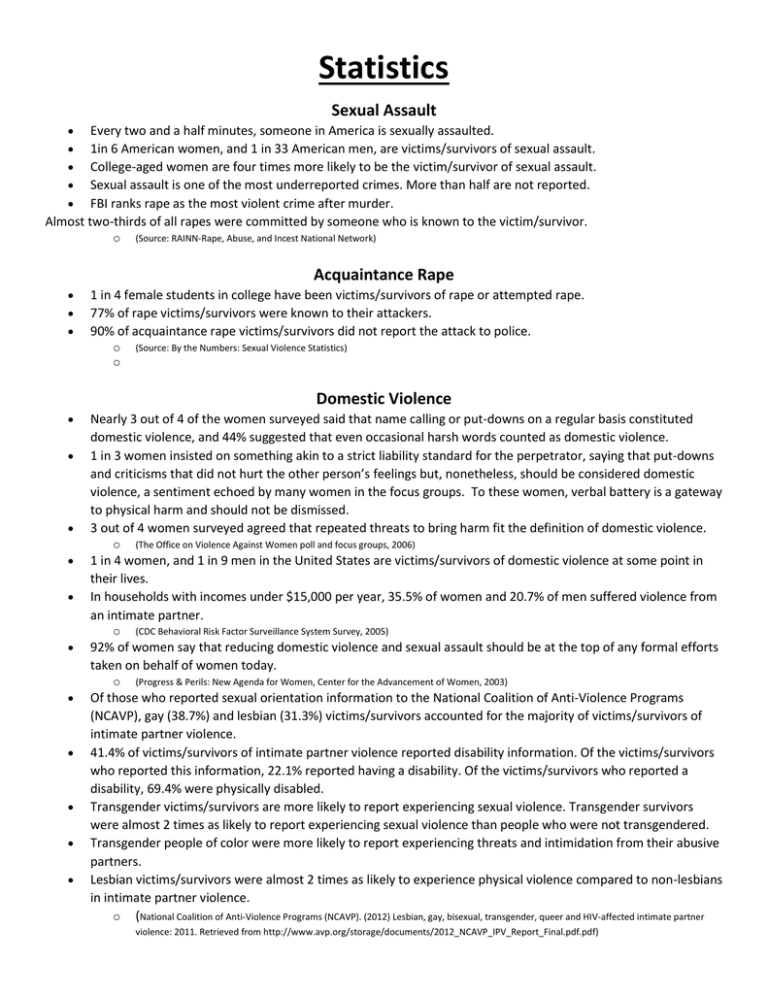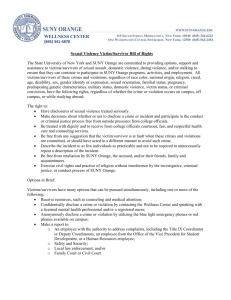
Statistics
Sexual Assault
Every two and a half minutes, someone in America is sexually assaulted.
1in 6 American women, and 1 in 33 American men, are victims/survivors of sexual assault.
College-aged women are four times more likely to be the victim/survivor of sexual assault.
Sexual assault is one of the most underreported crimes. More than half are not reported.
FBI ranks rape as the most violent crime after murder.
Almost two-thirds of all rapes were committed by someone who is known to the victim/survivor.
o
(Source: RAINN-Rape, Abuse, and Incest National Network)
Acquaintance Rape
1 in 4 female students in college have been victims/survivors of rape or attempted rape.
77% of rape victims/survivors were known to their attackers.
90% of acquaintance rape victims/survivors did not report the attack to police.
o
o
(Source: By the Numbers: Sexual Violence Statistics)
Domestic Violence
Nearly 3 out of 4 of the women surveyed said that name calling or put-downs on a regular basis constituted
domestic violence, and 44% suggested that even occasional harsh words counted as domestic violence.
1 in 3 women insisted on something akin to a strict liability standard for the perpetrator, saying that put-downs
and criticisms that did not hurt the other person’s feelings but, nonetheless, should be considered domestic
violence, a sentiment echoed by many women in the focus groups. To these women, verbal battery is a gateway
to physical harm and should not be dismissed.
3 out of 4 women surveyed agreed that repeated threats to bring harm fit the definition of domestic violence.
o
(The Office on Violence Against Women poll and focus groups, 2006)
1 in 4 women, and 1 in 9 men in the United States are victims/survivors of domestic violence at some point in
their lives.
In households with incomes under $15,000 per year, 35.5% of women and 20.7% of men suffered violence from
an intimate partner.
o
(CDC Behavioral Risk Factor Surveillance System Survey, 2005)
92% of women say that reducing domestic violence and sexual assault should be at the top of any formal efforts
taken on behalf of women today.
Of those who reported sexual orientation information to the National Coalition of Anti-Violence Programs
(NCAVP), gay (38.7%) and lesbian (31.3%) victims/survivors accounted for the majority of victims/survivors of
intimate partner violence.
41.4% of victims/survivors of intimate partner violence reported disability information. Of the victims/survivors
who reported this information, 22.1% reported having a disability. Of the victims/survivors who reported a
disability, 69.4% were physically disabled.
Transgender victims/survivors are more likely to report experiencing sexual violence. Transgender survivors
were almost 2 times as likely to report experiencing sexual violence than people who were not transgendered.
Transgender people of color were more likely to report experiencing threats and intimidation from their abusive
partners.
Lesbian victims/survivors were almost 2 times as likely to experience physical violence compared to non-lesbians
in intimate partner violence.
o (National Coalition of Anti-Violence Programs (NCAVP). (2012) Lesbian, gay, bisexual, transgender, queer and HIV-affected intimate partner
o
(Progress & Perils: New Agenda for Women, Center for the Advancement of Women, 2003)
violence: 2011. Retrieved from http://www.avp.org/storage/documents/2012_NCAVP_IPV_Report_Final.pdf.pdf)
Domestic Violence and Sexual Assault in Illinois
There were 115,988 reported cases of domestic violence in Illinois in 2009.
There were 3,762 reported violations of protection orders in Illinois in 2009.
38.9% of domestic crimes in Illinois were committed by a spouse, ex-spouse or common-law spouse in
2009.
5,316 criminal sexual assault cases were reported in Illinois in 2009.
1,272 of reported criminal sexual assault cases ended in an arrest in 2009.
3.6% of criminal sexual assaults in Illinois involved children in 2009.
42% of crimes against children were committed by a family member in Illinois in 2009.
o
(Illinois State Police. (2010) Crime in Illinois 2006: Annual uniform crime report. Retrieved from
http://www.isp.state.il.us/crime/cii2009.cfm)
Stalking
6.6 million people are stalked each year in the United States.
1 in 6 women (16.2%) and 1 in 19 men (5.2%) in the United States have experienced stalking
victimization at some point during their lifetime in which they felt very fearful or believed that they or
someone close to them would be harmed or killed.
11% of stalking victims/survivors have been stalked for more than 5 years.
o
Two-thirds (66.2%) of female victims/survivors of stalking were stalked by a current or former intimate
partner; men were primarily stalked by an intimate partner or an acquaintance, 41.4% and 40.0%,
respectively.
Repeatedly receiving unwanted telephone calls, voice, or text messages was the most commonly
experienced stalking tactic for both female and male victims/survivors of stalking (78.8% for women
and 75.9% for men).
More than half of female victims/survivors and more than one-third of male victims/survivors of
stalking indicated that they were stalked before the age of 25; about 1 in 5 female victims/survivors
and 1 in 14 male victims/survivors experienced stalking between the ages of 11 and 17.
Approximately 1 in 3 multiracial non-Hispanic women (30.6%) and 1 in 4 American Indian or Alaska
Native women (22.7%) reported being stalked during their lifetimes. One in 5 Black non-Hispanic
women (19.6%), 1 in 6 White non-Hispanic women (16.0%), and 1 in 7 Hispanic women (15.2%)
experienced stalking in their lifetimes.
o
(National Center for Victims of Crime: Stalking Resource Center (2012) Stalking Fact Sheet. Retrieved
from http://www.victimsofcrime.org/docs/src/stalking-fact-sheet_english.pdf?sfvrsn=4)
(National Intimate Partner and Sexual Violence Survey, 2011).
On college campuses, 3 in 10 college women report being injured emotionally or psychologically from
being stalked, and 80% of campus stalking victims/survivors know their stalker.
o
(www.wgac.colostate.edu/stalking).


